by America’s Majority Foundation
. . .
. . .
Opening
There have been many studies detailing the complete failures of the Lockdowns. One study, conducted by Jay Bhattacharya and John Ioannidis concluded, “In summary, we fail to find strong evidence supporting a role for more restrictive NPIs in the control of COVID in early 2020. We do not question the role of all public health interventions, or of coordinated communications about the epidemic, but we fail to find an additional benefit of stay at-home orders and business closures. The data cannot fully exclude the possibility of some benefits. However, even if they exist, these benefits may not match the numerous harms of these aggressive measures. More targeted public health in interventions that more effectively reduce transmissions may be important for future epidemic control without the harms of highly restrictive measures.” 1
In a speech to Hillsdale College, Scott Atlas noted, “Besides their limited value in containing the virus, lockdown policies have been extraordinarily harmful. The harms to children of suspending in-person schooling are dramatic, including poor learning, school dropouts, social isolation, and suicidal ideation, most of which are far worse for lower income groups. A recent study confirms that up to 78 percent of cancers were never detected due to missed screening over a three-month period. If one extrapolates to the entire country, 750,000 to over a million new cancer cases over a nine-month period will have gone undetected. That health disaster adds to missed critical surgeries, delayed presentations of pediatric illnesses, heart attack and stroke patients too afraid to go to the hospital, and others—all well documented. Beyond hospital care, the CDC reported four-fold increases in depression, three-fold increases in anxiety symptoms, and a doubling of suicidal ideation, particularly among young adults after the first few months of lockdowns, echoing American Medical Association reports of drug overdoses and suicides. Domestic and child abuse have been skyrocketing due to the isolation and loss of jobs. Given that many schools have been closed, hundreds of thousands of abuse cases have gone unreported, since schools are commonly where abuse is noticed. Finally, the unemployment shock from lockdowns, according to a recent National Bureau of Economic Research study, will generate a three percent increase in the mortality rate and a 0.5 percent drop in life expectancy over the next 15 years, disproportionately affecting African Americans and women. That translates into what the study refers to as a “staggering” 890,000 additional U.S. deaths. We know we have not yet seen the full extent of the damage from the lockdowns, because the effects will continue to be felt for decades. That is why lockdowns were not recommended in previous pandemic response analyses, even for diseases with far higher death rates.” 2
Professor Wilfred Reilly conducted two separate studies on the impact of comparing Democrat states to Republican states as well as comparing lockdown states compared to non-lockdown states from April to August 2020 for Americas Majority Foundation. He found that Republican states had lower unemployment rates as Republican state’s unemployment dropped from 13.2 percent to 6.5 percent and Democrats went from15.2 percent to 8.2 percent. Lockdown states in April 2020 had unemployment rates at 15 percent before dropping to 8.2 percent. Non lockdown states begin with unemployment rates of 10.9 percent before dropping to 5.5 percent. And his
analysis of the data showed there was no significant difference in deaths per capita between Republican and Democratic states. 3
Americas Majority Foundation has been following up, on a weekly basis, both economic data and deaths from the Corona virus. We looked at the data in four different ways and found that there was little difference in death from Covid but there was a significant difference in economic performance between Republican states and Democratic states as well as non-lockdown states and lockdown states. In comparing the bigger Democratic states and bigger Republican states, we found that there was significant difference in economic performance and Democratic states under performed in job creation and unemployment compared to Republican states.
This study is a follow up to earlier study released in May of 2021 in which we reviewed the trade-offs, in particular the economic trade-offs and we concluded that the lockdown and economic restrictions were not worth the cost.
When you add the overall health cost of missed diagnosis, missed screenings, and delayed treatment for chronic diseases, mental health issues resulting in higher suicides and drug overdoses impacting younger patients plus watching children falling behind in learning as schools were shut down, the conclusion has to be the economic restrictions and lockdowns were a complete failure. That was our conclusion in May of 2021 and the data still support these conclusions as we are seeing millions of workers unemployed who should be working. Morris Altman noted, “The current dominant view also tends to ignore the longer-term effects of lockdown related policies. Preliminary evidence suggest that lockdown policy will have significant negative impacts on socio-economic wellbeing, by increasing death rates, increasing poverty, deducing human capital, increasing mortality rates, and reducing life expectancy, causing significant bankruptcies and dramatically increasing government debt. These costs need to be brought into play when evaluating lockdown-based policy. And, given available alternatives, it does not appear that extreme lockdown is the optimal approach to addressing the Covid-19 pandemic. On the other hand, it is critical to understand that lockdown requires other significant policies to effectively minimize the deadly Smart thinking, lockdown and Covid-19: Implications for public policy impact of Covid-19. Once again, the choice is not a binary one. Overall, a broader and more nuanced decision-making perspective recognizes that there is no necessary trade-off between minimizing the short- and long-run effects of Covid-19 whilst keeping the economy open in the context of appropriate policy design that is in place and enforced.” 4
The experts including even economists failed to consider both the long-term economic impact of the lockdowns as well as the tradeoffs in health and wellbeing. Mikko Packalen and Jay Bhattacharya made this point about the silence of many economists for failing to speak up about the lack of the consideration of the impact of the lockdowns and the tradeoffs. They wrote, “Inherent in the profession’s lockdown analyses even though those analyses were often by people with little or no prior training or interest in epidemiology or public health, and even though those analyses served to support the most intrusive government policies in a generation. Economists did not heed epidemiologists’ prior warnings about the need to be very humble when connecting insights from models to our complex reality., The fact that economists’ concern for
the poor vanished so quickly in the Spring of 2020 also speaks of a distinct lack of empathy.. One-size-fits-all decrees from politicians do not enhance health outcomes as much as they blind us to the actions (or lack thereof) that would protect us the most—or not. Freedom on its own is a virtue, and it produces crucial information… Rather than hide behind the false belief that lockdowns are a free lunch, it is crucial that economists soon evaluate the global impacts of rich countries’ lockdowns.” 5
Many things need to be considered when reviewing the failure of the response to the COVID pandemic. Education of our children is a good example as McKinsey and Company showed school closure resulted in months of loss learning. Overall, students lost at least 7 months, with White children losing 6 months, Hispanics 9 months, Blacks 10 months and low income overall regardless of race lost 12 months of learning.
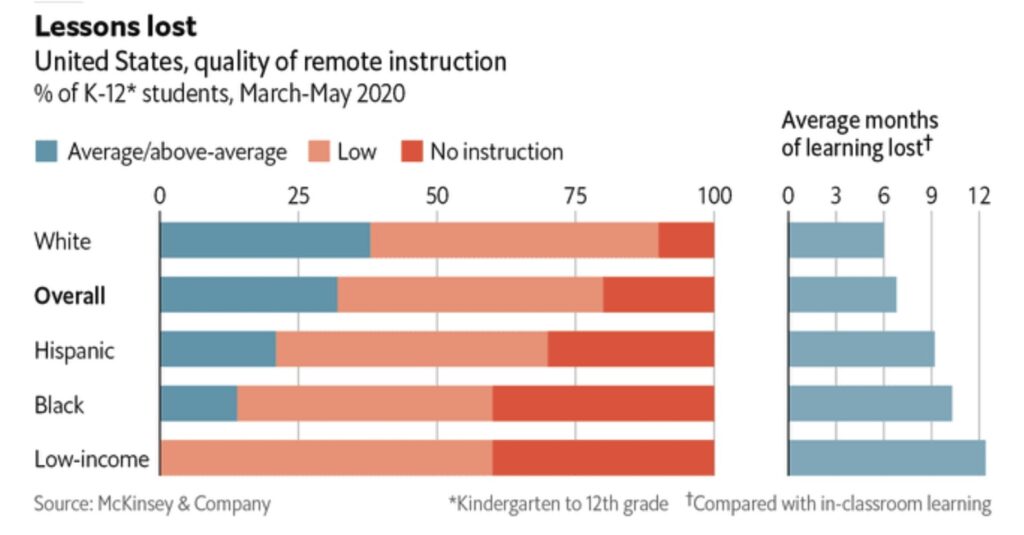
Just as Republican states benefitted economically from allowing businesses to re-open, they also open schools earlier, giving students more opportunity to be educated. One study estimated that students will lose over two trillion dollars of income over their lifetime due to closing of in class learning. The researchers noted, “Here’s a more disturbing fact: A large body of evidence is showing that students in high-poverty schools, students of color and white students who were scoring below grade level before the pandemic have lost the most ground academically. Most surprisingly, those white and Asian students who were scoring in the top quartile before the pandemic have returned to school this fall on track — with no loss in expected growth — as if there had been no pandemic! In other words, communities of color and those experiencing poverty have not only borne the brunt of job and wage losses, but their children have borne the brunt of the academic losses as well.” 6 This reinforces what McKinsey noted, students lost ground in particular minorities.
Nine of the top ten states with the highest schooling participation rate had Republican governors and nine of the bottom ten states with the lowest percentage of students back in the classrooms had Democratic governors. 21 of the top 25 states with the highest participation rates of students in the classroom had Republican governors.

Review of the Data
Since summer of 2020. We have followed deaths per capita and unemployment of Republican and Democratic states. Dr. Reilly’s lockdown research included reviewing different variables including density of population and his research verified our own data that there were significant differences in unemployment between Republican and Democratic states and his data validated our own weekly review.
This study is similar to the study we completed in May of 2020 as we compared states with Republican governors versus states with Democrat governors, states in which Republicans and Democrats control both the legislature and governor seat and finally the top four populous states with Republican governors and top four populous states with Democratic governors. The later data analysis features states with similar demographics.
Larger Republican states have 56% White vs 57% White in Larger Democratic states, Republican states have 34% black and Hispanics vs 31% in Democratic states and Democratic states have 8.5% Asian voters versus 3% in Republican states. The average age in the Republican populous states was 39 vs 38 in Democratic states. In these eight states, Democrats may have a slight advantage as Republican states are slightly older with more Hispanics and Blacks who had worse outcomes with the Corona virus.

After looking at Democratic and Republican states in different ways, the results were the same. Republicans had significant less unemployment than Democratic states.
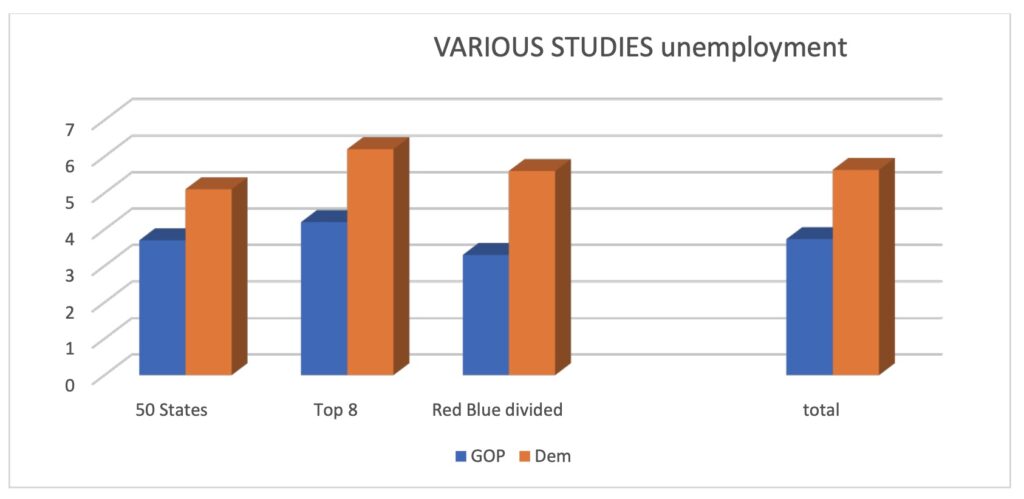
States with Republican governors had 3.7% unemployment compared to 5.1% for Democratic governors. This trend has been consistent since August 2020 as Republican states had less unemployment 6.4% to Democratic states 8.4%. In March 2021, the unemployment for Republican states was 4.6% versus 6.4% in Democratic states. This trend was consistent and one major reason was that most Republican states had less restrictions and were less dependent upon lockdown strategy or enforcing mandates.
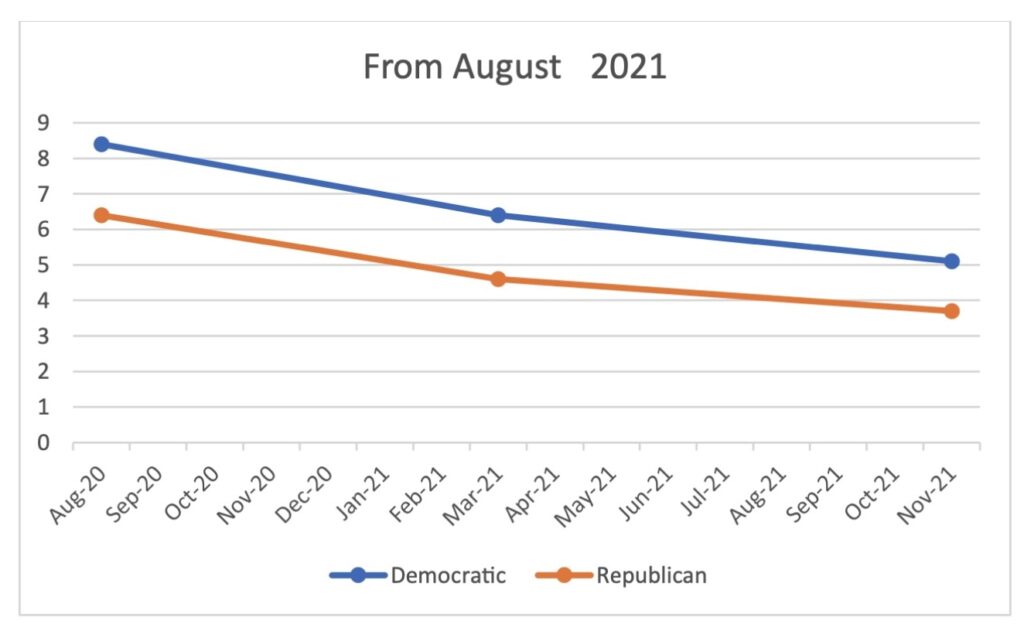
Nor was there a significant difference in deaths per capita as GOP governors had 251 per 100,000 vs. 224 per 100,000 under Democratic governors for a difference of only twenty seven per 100,000. Both Republican and Democratic governors saw significant increases in death per capita.
GOP governors saw an increase of 35 percent death per capita since March but Democratic governors saw an increase of 29 percent, showing the virus continue to spread in spite of steps taken by governors.
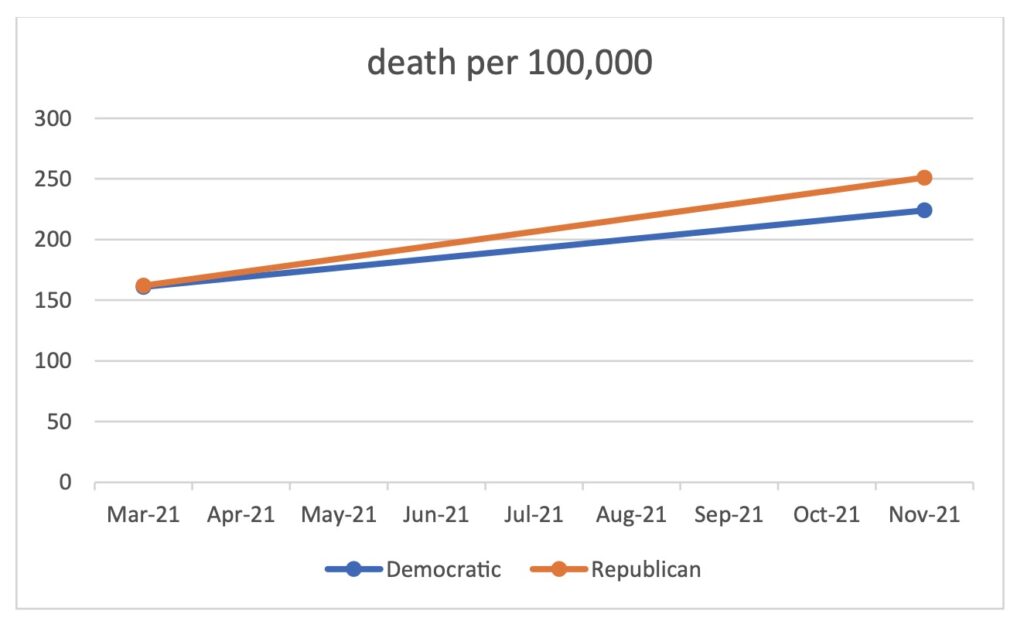
When looking at more populous states, GOP governors had an unemployment of 4.2% vs. 6.2% for Democratic governors and when we compared states where Republicans controlled both the legislature and governor seat had unemployment of 3.3% versus 5.3% for Democratic states. Regardless of how you defined Republican states or the size of the states, Republican states had superior job creation. While many will judge the success of a governor’s response in terms of deaths per capita, other metrics are equally important for the long-term health of a state’s residents.
Scott Atlas noted that the number of deaths from or with COVID is premature because over the next two decades there may be a higher total of deaths associated with the second order effects of the lockdowns and restrictions. Kevin Roche referenced a study showing that drug overdose deaths doubled among adolescents, and this is a cost that is often ignored. 7 The cost to our younger workers and school children has been far too high and no one should argue that the economic restrictions and closing schools to in class learning was worth the price of the lockdowns. More teenagers and young workers died from policies resulting from the lockdown as opposed to death from the virus itself.

When you look at the overall comparison between states death per capita regardless of states definition there was little difference as we are seeing nor more than 33 per 100,000 but the number of people unemployed in Democratic states were significant as millions of workers are not working. There are millions of workers less than February 2020 where the overall unemployment was 3.5 percent and before the massive losses in jobs due to Pandemic and the resulting policies. Most of those job losses are located in Democratic states as Republican states overall were close to the 3.5 per cent of February 2020 but Democratic states are significantly above the present national unemployment.
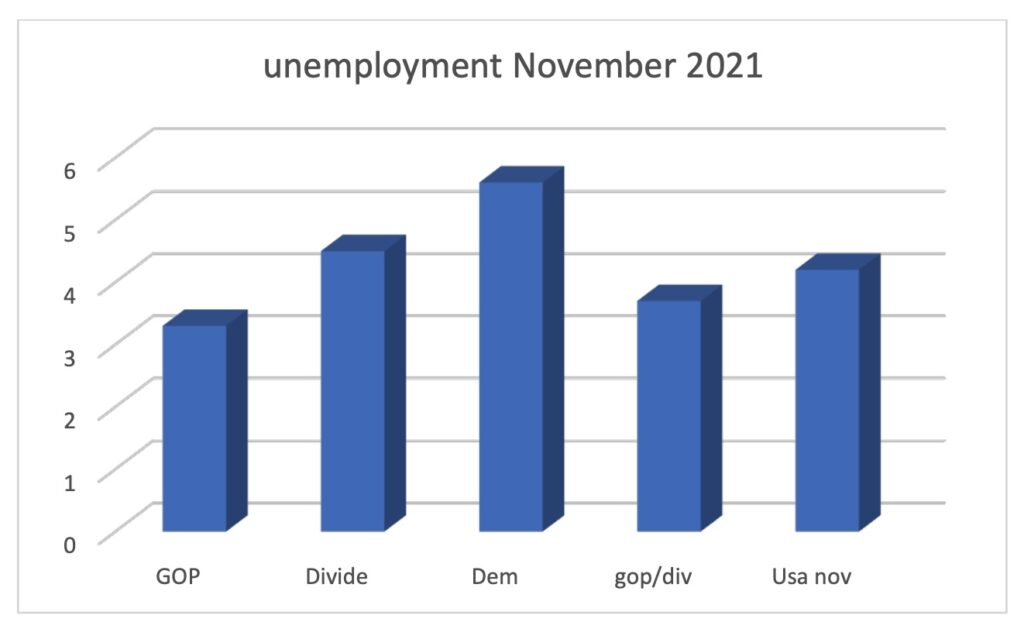
When we look closer at data, we notice that states with Republican having complete control of government had unemployment rate of 3.3 percent compared to 4.5 percent of states with both
parties controlling portion of the government while states run totally by Democrats was 5.3 percent. Republican states are consistently under the national average and that translates to millions more working in Republican states. Just looking at the unemployment rates alone would question the wisdom of the various strategy to restrict economic activities including vaccine and mask mandates that restrict employment, closing schools and lockdowns that failed to stem the virus spread.
Citizens are now choosing the COVID response they can survive by moving. Thirty states saw total higher migration and twenty had Republican governors while those states who lost citizens, 65 percent had Democratic governor with nearly 720,000 leaving two states–New York and California. Both states are among the worse in unemployment and had some of the worse economic restrictions and lockdowns. Nor can you say people are leaving California due to weather, so you have to conclude that loss of economic opportunities due to policies of these governors dealing with the pandemic are a significant reason for leaving.

We saw similar data with lockdown and non- lockdown states. In Wilfred Reilly’s paper, lockdown states had 15 percent unemployment in April before moving down to 8.2 percent unemployment in August compared to non-lockdown states which had unemployment rates of 10.9 percent in April to 5.5 percent in August. In the winter of 2020, many states reestablished lockdown and economic restrictions and those states who lockdown had an unemployment rate of 4.6 percent versus 3.4 percent for non-lockdown states. Just as Republican state unemployment were significantly lower than Democratic states, non-lockdown states unemployment were significantly lower than lockdown states and non-lockdown states were all Republicans, so this impacted the difference between Republican and Democratic states.
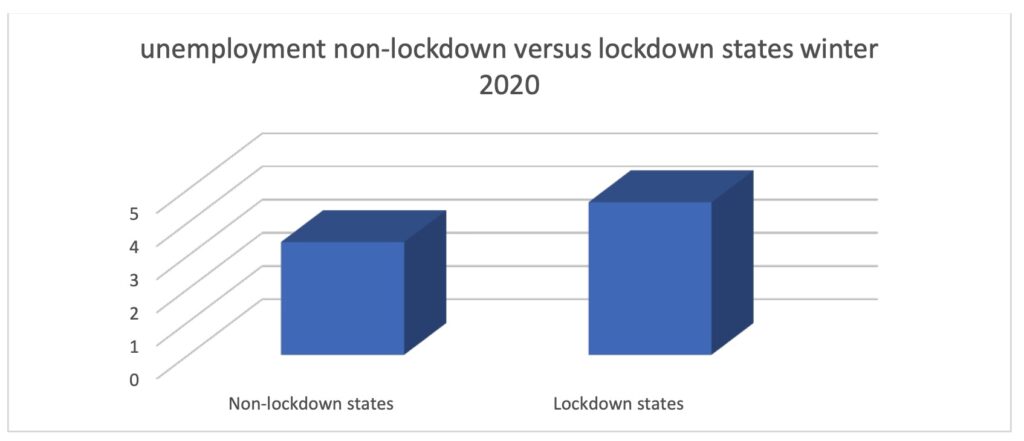
Conclusion
In looking at our response to the pandemic, we need to look at various metrics including impact on children education and overall mental health, reduced screening and treatment for chronic diseases and small businesses out of businesses and millions of unemployed unnecessarily.
In reviewing other studies, we have witnessed increase of drug overdoses among younger workers and teenagers, children falling behind in learning, and increase premature deaths over the next two decades showing the failure of our economic restrictions and lockdown strategies. We saw significant increases in death per capita regardless of strategy pursued but we found that millions more were employed in Republican states versus their Democratic counterpart. This is a trend that has been seen consistently throughout the pandemic. Republican strategy of reducing economic restrictions and lockdown while opening up schools have resulted in far less unemployment and while Republican states have slightly higher deaths per capita, the other metrics favor Republicans. Americans appear to agree as they are moving to Republican states in big numbers and leaving many major Democratic states. California and New York are biggest loser in this. New York is 48th in highest unemployment and California is 50th. California is also last in the nation with students in class learning and New York is ranked 38th.
Kevin Roche summed up the reason for the failure of the economic restrictions and lockdowns when he noted, “The truisms I have known and stated since the start should now be apparent to everyone. You are not, we are not, going to suppress a respiratory virus. It will be here, we will have to adapt to that, and we can’t destroy our society in that adaption effort.” 8
We are talking about a virus that may have killed .2 to .4 percent which is slightly more than the normal flu season and the Omicron virus appears to be less lethal than its previous variants. John Ioannidis in a worldwide study of data had the global data at .15 percent. 9 John Ioannidis and Cathrine Oxfords noted that overall IFR was age dependent as they found, “Twenty-three seroprevalence surveys representing fourteen countries were included. Across all countries, the median IFR in community-dwelling elderly and elderly overall was 2.4% (range 0.3%-7.2%) and 5.5% (range 0.3%-12.1%). IFR was higher with larger proportions of people >85 years. Younger age strata had low IFR values (median 0.0027%, 0.014%, 0.031%, 0.082%, 0.27%, and 0.59%, at 0-19, 20-29, 30-39, 4 0-49, 50-59, and 60-69 years).” 10 Ioannidis even concede that in the United States, the IFR maybe at .3 to .4. which was two to three times the normal flu season but another way to look at it, the average flu season kills 1 per thousand and this virus kills maybe 2 to 4 per thousands. We are talking maybe 1 to 3 more deaths per 1000 and that is the number that resulted in the policies followed. These numbers should have shown any policy makers that we are talking putting in lockdown on a virus that may be slightly higher than the average flu season and we have seen flu pandemic such as the 1957-58 pandemic whose IFR was closer to this virus.
This virus impacted the elderly and those with underlying conditions, a more limited strategy to protecting the most vulnerable would have been more effective and less costly to society. Republican states had less unemployment and so did non-lockdown states and the difference represent millions of workers out of work. This is but one metric that has to be consider in judging the success or failure of the lockdown strategy, and this metric shows the failure of the strategy. When you combined the increase unemployment in both lockdown and Democratic states, and that the virus continued to spread regardless of what was done. Many Americans have voted with their feet to many of these Republican states due to these policies.
. . .
. . .
Footnotes
1. Assessing mandatory stay-at-home and business closure effects on the spread of COVID-19 Eran Bendavid1,2 | Christopher Oh1 | Jay Bhattacharya2 | John P. A. Ioannidis1,3,4,
2. Science, Politics, and COVID: Will Truth Prevail? Scott W. Atlas Hoover Institution February 18, 2021, Hillsdale College
3. An Ignored Cost the Effect of Yes-No Lockdown Strategy, along with Red-Blue Political Partisanship and Other Variables, on April-August Unemployment across U.S. States Wilfred Reilly Associate Professor Kentucky State University with F. Jane Lingle Research Associate
4. Smart Thinking, Covid and lockdown, Implications for Public Policy Morris Altman Journal of behavioral Economics
5 Lockdown Harms and the Silence of Economists Mikko Packalen and Jay Bhattacharya Global Collateral
6. Analysis: Pandemic learning loss could cost U.S. Students $2 trillion in lifetime earnings and what states and schools can do to avert this crisis. Dan Goldhauber, Thomas Kane, Andrew McEachin. The 74
7. Healthy Skeptic – Coronamonomania Lives Forever, Part 76 (healthy-skeptic.com) Kevin Roche
8. Healthy Skeptic – Get the Hell Out of Here 2021 and Oh, Shit, Here Comes 2022 (healthy- skeptic.com) Kevin Roche
9. Reconciling estimates of global spread and infection fatality rates of COVID-19: An overview of systematic evaluations John P. A. Ioannidis
10. Infection fatality rate of COVID-19 in community-dwelling populations with emphasis on the elderly: An overview Cathrine Axfors, John P.A. Ioannidis